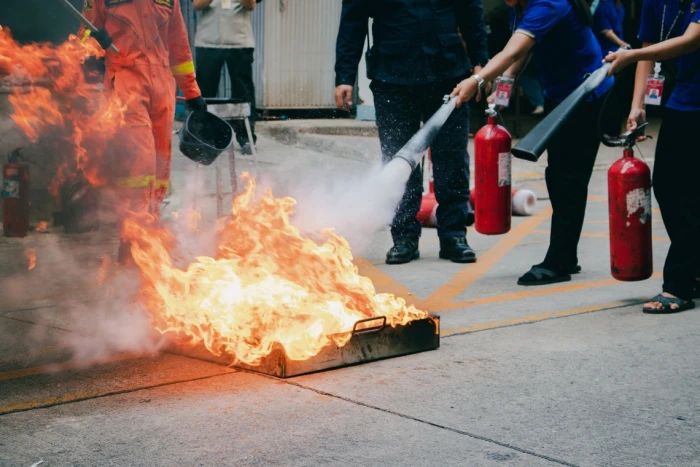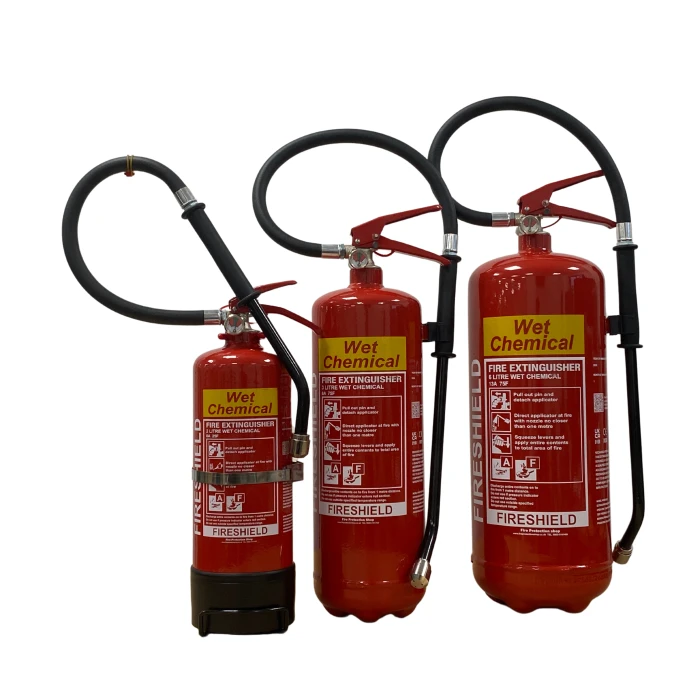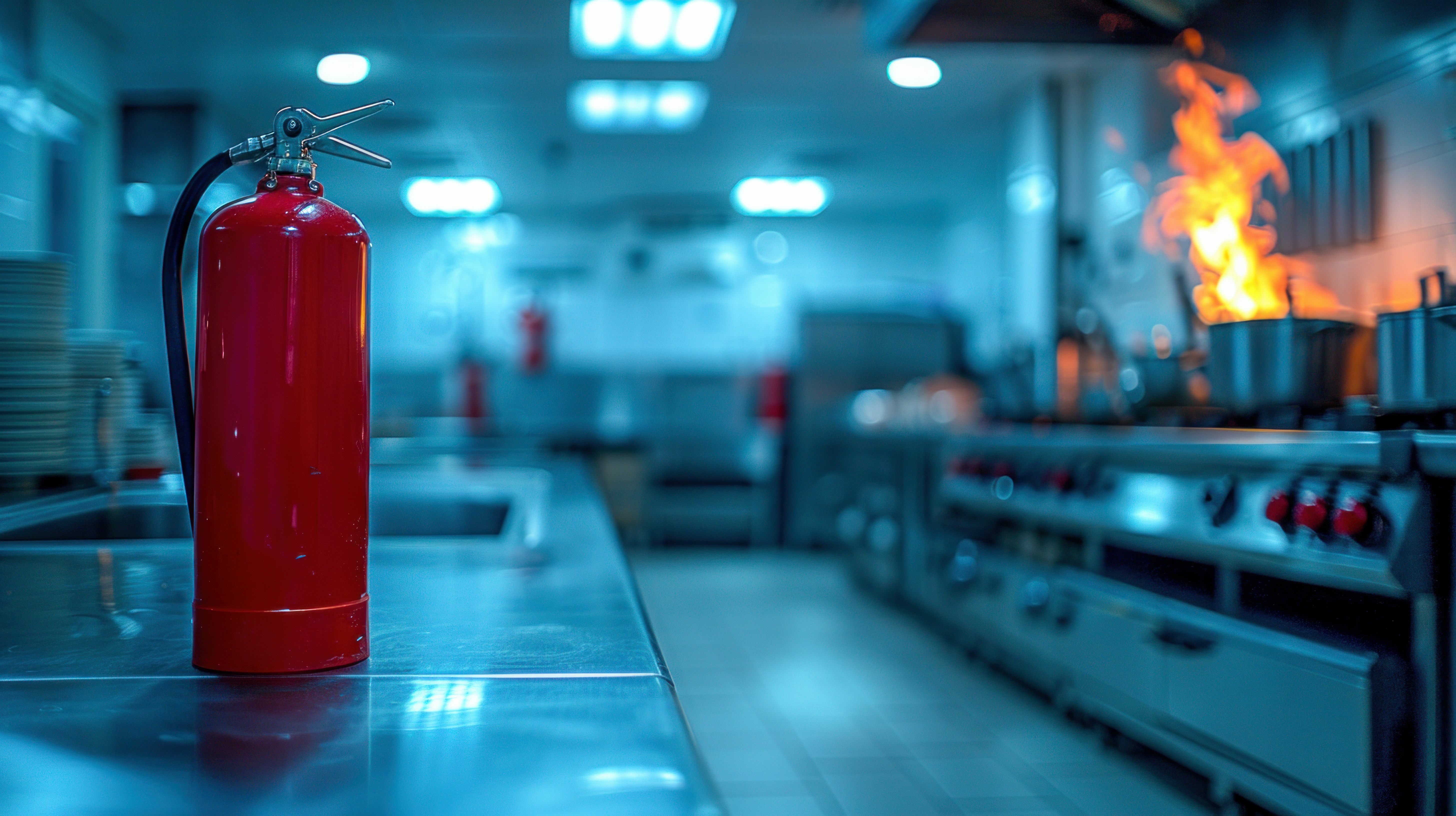
Need assistance?
Need Assistance? Call Us 0330 058 0631





















 Book a service
Book a service

12/06/2024 • by Lynsey B

Fire safety is essential in any setting, especially in environments where cooking with fats and oils is a daily activity. Wet chemical fire extinguishers are specifically designed to tackle Class F fires. They provide an essential line of defence in commercial kitchens and food preparation areas. Understanding how these extinguishers work, where they should be used and how to operate them can make a significant difference in ensuring fire safety.
Wet chemical fire extinguishers work by a process called saponification. When the wet chemical, typically a solution of potassium acetate, potassium carbonate or potassium citrate, is sprayed onto a fire involving cooking oils or fats, it reacts with the burning fat and creates a soapy foam layer. This foam acts as a barrier, cutting off the fire's oxygen supply and cooling the burning oils to prevent re-ignition. This dual action of smothering and cooling makes wet chemical extinguishers highly effective against Class F fires, which involve cooking oils and fats.
Wet chemical fire extinguishers are primarily used to combat fires that involve cooking oils and fats, known as Class F fires. These types of fires are common in kitchens and food preparation areas where high-temperature oils are used for frying and cooking. The unique composition of wet chemical extinguishers makes them suitable for these environments because they are specifically formulated to handle the high temperatures and volatile nature of burning fats and oils.
Wet chemical fire extinguishers should not be used on electrical fires (Class E), flammable gas fires (Class C), flammable liquid fires (Class B), metal fires (Class D), or any fire where the fuel source is uncertain. Wet chemical fire extinguishers are specifically designed for Class F fires involving cooking oils and fats. Using them on other types of fires can be dangerous and ineffective.

Several types of establishments can benefit hugely from having a wet chemical fire extinguisher on hand. These extinguishers are designed to handle fires involving cooking oils and fats, making them indispensable in environments where such materials are commonly used.
Food trucks are essentially mobile kitchens, often operating in compact spaces where multiple cooking processes are happening simultaneously. They typically use high-temperature cooking oils for frying foods such as chips and burgers. Due to the confined space and high risk of fire, having a wet chemical fire extinguisher is highly recommended. The quick action provided by these extinguishers can prevent a minor incident from escalating into a full-blown fire. This helps to ensure the safety of both the food truck operators and their customers.
Fast food restaurants are synonymous with deep frying. They frequently use deep fryers and large quantities of cooking oil to prepare their menu items. The constant high-temperature environment increases the risk of Class F fires. Wet chemical fire extinguishers are essential in these settings as they can effectively extinguish fires caused by burning oils. This helps to reduce the risk of damage to the property and injury to staff and patrons.
Whether in a commercial setting or a large-scale residential environment, kitchens that use oils and fats for cooking need the protection offered by wet chemical fire extinguishers. Commercial kitchens in hotels, catering companies and institutions like schools and hospitals often use high volumes of oil for cooking. A wet chemical fire extinguisher can quickly and efficiently tackle any fire involving these oils, preventing it from spreading and causing extensive damage. Even in large-scale residential kitchens, where cooking for events or large family gatherings involves frying, having a wet chemical fire extinguisher on hand provides peace of mind and safety.
Restaurants, especially those with open kitchens where customers can see the cooking process, need to maintain high safety standards. The presence of a wet chemical fire extinguisher ensures that any fire involving cooking oils can be quickly dealt with. In high-end restaurants with specialised cooking techniques and equipment, the risk of fire can be significant. Wet chemical fire extinguishers are designed to handle the specific challenges posed by burning oils. This makes them an invaluable addition to the restaurant’s fire safety measures.
Fish and chip shops are quintessentially associated with frying. This makes them particularly vulnerable to Class F fires. These establishments use large vats of oil to fry fish, chips and other items, creating a high-risk environment for fires. Having a wet chemical fire extinguisher on hand is critical to ensure the safety of the premises. In the event of a fire, the wet chemical extinguisher can quickly neutralise the flames, preventing the fire from spreading and causing extensive damage.
In the UK, wet chemical fire extinguishers are easily identified by a prominent yellow label. This label is strategically placed on the body of the extinguisher to help users quickly determine the type of extinguisher and understand its intended use. The primary body of the extinguisher remains red, in accordance with the standard colour coding system for all fire extinguishers. This helps maintain a consistent appearance across different types of extinguishers.
This colour coding system is part of a broader fire safety strategy aimed at preventing confusion during emergencies. Each type of extinguisher in the UK has a distinct colour label, such as blue for dry powder, cream for foam and black for CO2. This makes it straightforward for individuals to select the appropriate extinguisher based on the nature of the fire.

Wet chemical fire extinguishers come in various sizes to cater to different needs and environments. The 2-litre extinguisher is ideal for smaller kitchens and food preparation areas where space is limited but there is still a critical need for effective fire protection. These compact units can be easily stored and quickly accessed in tight spaces, providing immediate response capability.
The 3-litre extinguisher strikes a balance between capacity and ease of handling, making it suitable for medium-sized kitchens and food establishments. This size offers sufficient firefighting power while remaining manageable for users.
For larger kitchens and commercial establishments with extensive cooking operations, the 6-litre wet chemical fire extinguisher is the best choice. It provides ample firefighting capacity to handle more significant fire risks, ensuring comprehensive protection.
Selecting the appropriate size of the wet chemical fire extinguisher involves assessing the specific needs of the environment. You must also understand the potential fire hazards present and ensure that the extinguisher is easily accessible in case of an emergency. Proper placement and size selection can significantly enhance the safety and readiness of any kitchen or food preparation area.
.jpg)
Using a wet chemical fire extinguisher correctly is vital for effectively extinguishing a fire and ensuring safety. Firstly, assess the fire to ensure that it is suitable for a wet chemical extinguisher. Wet chemical fire extinguishers are specifically designed for Class F fires, which involve cooking oils and fats. If the fire involves other materials, it may require a different type of extinguisher. Once you have determined that it is a Class F fire, proceed to the next step.
Remove the safety pin to break the tamper seal. This action prepares the extinguisher for use. The safety pin prevents accidental discharge, so pulling it out is an essential step before you can operate the extinguisher. After removing the pin, aim the nozzle at the base of the fire. This is important because aiming at the base ensures that the wet chemical is applied directly to the source of the flames. For deep fat fryer fires, ensure the nozzle is directed at the surface of the burning oil. This helps to maximise the effectiveness of the extinguisher.
Squeeze the handle to discharge the wet chemical. It is important to maintain a steady grip and control the flow of the chemical. A controlled and consistent discharge will ensure that the wet chemical can form an effective foam layer over the burning oil. While discharging the wet chemical, move the nozzle in a gentle, sweeping motion to evenly distribute it. This technique helps to create a foam layer that covers the burning oil. It will cut off the fire’s oxygen supply and cool the flames. The sweeping motion ensures that the entire surface area of the burning oil is covered, which is essential for fully extinguishing the fire.
Monitor the fire continuously as you apply the wet chemical. Continue discharging the extinguisher until the fire is completely out. Keep an eye on the area for any signs of re-ignition and be prepared to reapply the wet chemical if necessary. It is important to ensure that the fire is fully extinguished to prevent it from flaring up again.
In addition to these steps, there are a few safety tips to keep in mind. Always maintain a safe distance from the fire to avoid injury from flames or hot oil splashes. Wet chemical extinguishers are designed to be used from a distance that keeps the user safe. Never use water on oil fires, as it can cause the fire to spread violently. Water can cause burning oil to splatter, which can exacerbate the fire and create additional hazards. If at any point the fire becomes too large to handle or if you are unsure about your ability to extinguish it, evacuate the area immediately and call the fire services. Ensuring your safety and the safety of others is the top priority.
Wet chemical fire extinguishers are essential tools in environments where cooking oils and fats are commonly used. However, like any safety equipment, they come with their own set of advantages and disadvantages.
Effective on Class F Fires: Wet chemical fire extinguishers are specifically designed to tackle fires involving cooking oils and fats. The chemical solution creates a soapy foam that cools the oil and cuts off the oxygen supply.
Prevents Re-Ignition: The wet chemical solution forms a stable, non-flammable layer over the burning oil. In turn, this prevents re-ignition even after the flames are extinguished. This is essential for fires involving high-temperature oils.
User-Friendly: These extinguishers are designed to be easy to operate, ensuring that even those with minimal training can use them effectively during an emergency.
Versatility: In addition to Class F fires, wet chemical extinguishers can also be used on Class A fires involving solid combustibles like paper and textiles. This makes them versatile tools in kitchens where various types of fires might occur.
Minimal Residue: The residue left by the wet chemical agent is relatively easy to clean up compared to some other types of extinguishing agents, making post-fire restoration quicker and less complicated.

Limited Application: While wet chemical extinguishers are highly effective on Class F and Class A fires, they are not suitable for all types of fires. They should not be used on electrical fires (Class E) or flammable gases (Class C), which limits their overall applicability.
Size and Weight: Wet chemical extinguishers can be heavier and bulkier compared to other types, which might make them less convenient to store and handle, particularly in smaller or more confined spaces.
Specialised Training Required: Although user-friendly, these extinguishers still require specific training to ensure they are used correctly. Misuse can lead to ineffective firefighting or even exacerbate the fire situation.
Initial Cost: Wet chemical extinguishers can be more expensive to purchase compared to some other types of extinguishers. This higher initial cost might be a consideration for smaller businesses or residential users.
09/08/2024 • by Lynsey B
We use cookies to enhance your site experience. Choose your preferences below.
